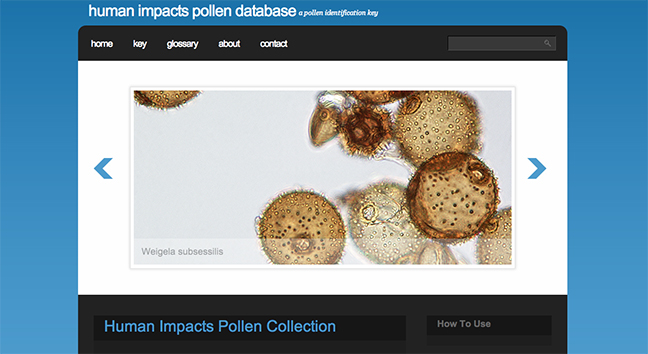
Database
Our pollen reference collection comes predominantly from plants found in the temperate northeast North America, and smaller collections of plants from the southwest United States and Iceland. As part of historical archaeological research group, our collections explicitly focus on plant taxa useful for understanding contexts of plant-human interactions: cultigens, ornamentals, weeds, and plants associated with disturbed habitats as well as the standard pollen collections of arboreal and non-arboreal pollen. Our collection includes more than 1200 specimens. Images are added regularly.
Search and Image Options
This database is designed for simplicity and flexibility, accessible even for the novice user. The database can be searched by taxonomic group (family or genus) or morphological characteristics (aperture and sculpturing).
Microscopy
Images were obtained using a Nikon Labophot microscope. Extended depth of field imaging was obtained using Nikon NIS-Elements software.
Nomenclature
Taxonomic nomenclature follows IPNI database (www.ipni.org/index), and morphology according to Kapp, Davis, and King (2000), Erdtman (1952), McAndrews (1973), Moore and Webb (1978), and Moore, Webb, and Collinson.
How to cite
Trigg, H., S. Jacobucci, M. Henkel, and J. Steinberg. 2013. Human Impacts Pollen Database, an Illustrated Key. Andrew Fiske Center for Archaeological Research, University of Massachusetts Boston.
References
Erdtman, G. Pollen Morphology and Plant Taxonomy: Angiosperms. Almqvist and Wiksells: Uppsala, 1952.
Kapp, R., Owen Davis, and James King. Pollen and Spores. American Association of Stratigraphic Palynologists Foundation Publication, 2000.
Moore, P.D. and J.A. Webb. An Illustrated Guide to Pollen Analysis. Halsted Press: New York. 1978.
Moore, P.D., J.A. Webb, and M.E. Collinson. Pollen Analysis. Blackwell Scientific Publications: Oxford. 1991.
Acknowledgments
The authors would like to thank Arnold Arboretum (Kyle Port), Gray Herbarium Harvard University (Emily Wood), Phil Tonne and Timothy Lowrey (University of New Mexico Herbarium), Lystigardurinn Arctic Botanical Gardens (Akureyri, Iceland), Debra Branker (Welchman Hall Gully, Barbados) for permission to collect flowers from their plants and herbarium specimens, and Robert Morris and Robert Stevenson (University of Massachusetts Boston) for advice with the creation and deployment of the key.
HIPD_Specify
The Human Impacts Pollen collection is managed in Specify6 (see specify software.org), and provides that data presentation that conforms to biodiversity informatics standards. The data entered in the Specify database is sufficient to enable users to find the specimen records of the original sources of the pollen. The Specify database for the HIPC has been exported to an Excel file, which can be downloaded here.
|